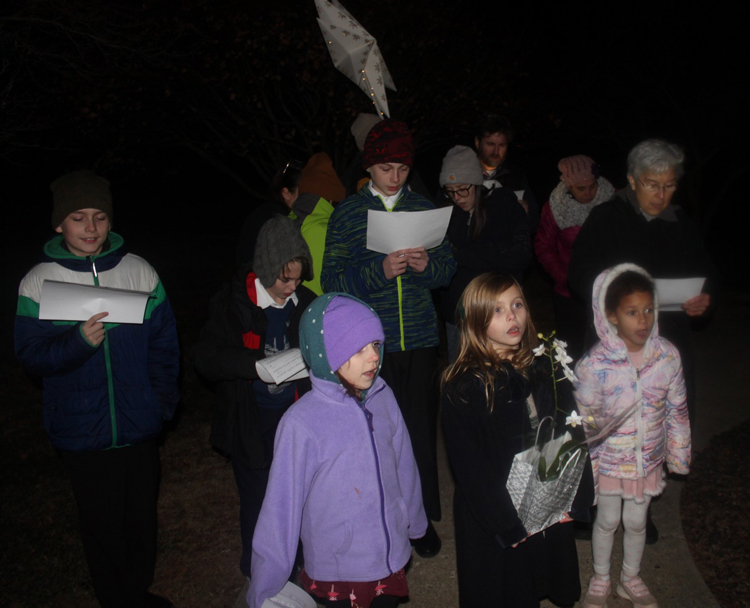2023 Sun Jan 1
Videos, Jan 1, 2023 – Lessons and Carols
1. Introduction
2. Bidding Prayer
3 saints after Christmas Day
1. St. Stephen Dec. 26
Stephen was among the earliest Christian martyrs, stoned to death for his beliefs. St. Paul not only witnessed the event but held the garments of those stoning Stephen which he regretted later on and carried a lasting sense of guilt.
2. John the Apostle Dec. 27
John, one of the Apostles, possibly lived the longest life associated with the Gospel, an author in that time and Evangelist spreading the Gospel to many in the Mediterranean area who were not of Jewish background. He is believed to be the only Apostle not martyred for the cause. He is associated with the Gospel that bears his name, 3 Epistles and possible authorship of the Book of Revelation.
3. Holy Innocents Dec. 28
The term “Holy Innocents” comes from Matthew’s Gospel Chapter 2. When Jesus was born in Bethlehem, King Herod, fearing for his throne, ordered that all the male infants of Bethlehem two years and younger be killed. These children are regarded as martyrs for the Gospel — “martyrs in fact though not in will.” This can be compared to the conduct of Pharoah in Exodus 1:16. “When you are helping the Hebrew women during childbirth on the delivery stool, if you see that the baby is a boy, kill him; but if it is a girl, let her live.”
January 1, Lessons and Carols

Jan 1, 2023 – 11am -A Festival of Nine Lessons and Carols is the Christmas Eve service held in King’s College Chapel, Cambridge England and was introduced in 1918.
Kings College Cambridge holds this service every Dec. 24. The main gate to Kings College opens at 7:30am for the 3pm service. Many people get in the line by 5am for a 10 hour wait!
The 2022 service
It was conceived by Eric Milner-White, the Dean of the College, for Christmas Eve 1918 whose experience as an army chaplain in World War I had led him to believe that more imaginative Christmas worship was needed by the Church of England. He actually reached back to an earlier time for a service structure.
The original service was, in fact, adapted from an Order drawn up by E.W. Benson, later Archbishop of Canterbury, for use in the wooden shed, which then served as his cathedral in Truro, at 10 pm on Christmas Eve 1880. AC Benson recalled: ‘My father arranged from ancient sources a little service for Christmas Eve – nine carols and nine tiny lessons, which were read by various officers of the Church, beginning with a chorister, and ending, through the different grades, with the Bishop.”
The story of the fall of humanity, the promise of the Messiah, and the birth of Jesus is told in nine short Bible readings from Genesis, the prophetic books and the Gospels interspersed with the singing of Christmas carols, hymns and choir music. The readings can vary as can the music. Traditionally, “Once in Royal David City” is the opening hymn. Beyond that the service is flexible.
An opening prayer that is used provides a focus:
“We gather here to recall the mystery of our redemption. Though sin drew us away from God, he never stopped loving us. The prophets told of the coming of a Messiah who would initiate a reign of justice and peace. This promise was fulfilled in the incarnation of Jesus Christ. Let us now reflect with joy on this wondrous mystery.”
Lessons and Carols is usually done at the beginning of Advent as an introduction to Advent or towards the end as a summary of all that has happened.
This St. Peter’s service is the perfect culmination of your Christmas week, a joyous celebration along with thoughtful, introspective moments. Plan now to attend.
King’s College Cambridge – As you have never seen it
The famous church in England, home of Lessons and Carols, built by Henry VII is altered by projectionist, Miguel Chevalier.
To illustrate Stephen Hawking’s research about black holes, Miguel Chevalier imagines an immersive environment made up of thousands of constellations that plunge the guests into the mystery of the universe.

Prayer of Thanksgiving for the year just past…
God of new beginnings, we thank you for the year just past, with all of its joys and wonders. We thank you for all that we were able to do together . We thank you for giving us opportunities to serve You well and in doing so to let your light shine in our church and out in our world. We pray now for Your guidance in this new year, and for the courage to follow You wherever You would lead us. We pray for the strength to carry out everything that You will give us to do. And may our love for one another reflect the transforming love that You have for each one of us. In Jesus’ name we pray. Amen

And a Blessing for the New Year!
From Pastor Dawn Hutchings

“The art of blessing is often neglected. The birth of a New Year calls forth the desire in us to bestow a blessing upon those we love. Several years ago, John O”Donohue, one of my favorite Irish poet’s created a New Year’s blessing for his mother entitled Beannacht-for Josie. It is a blessing of superior quality. And so, on this New Year’s Eve, may you all receive this beannacht with my added blessing for a peace-filled New Year in which the God in whom all of creation is held, might find full expression in your miraculous life!”
Beannacht – A New Year Blessing John O’Donohue
On the day when The weight deadens On your shoulders And you stumble, May the clay dance To balance you.
And when your eyes Freeze behind The grey window And the ghost of loss Gets into you, May a flock of colours, Indigo, red, green And azure blue, Come to awaken in you A meadow of delight.
When the canvas frays In the currach of thought And a stain of ocean Blackens beneath you, May there come across the waters A path of yellow moonlight To bring you safely home.
May the nourishment of the earth be yours, May the clarity of light be yours, May the fluency of the ocean be yours, May the protection of the ancestors be yours. And so may a slow Wind work these words Of love around you, An invisible cloak To mind your life.
The Work of Christmas
When the song of the angels is stilled,
When the star in the sky is gone,
When the kings and princes are home,
When the shepherds are back with their flock,
The work of Christmas begins:
To find the lost,
To heal the broken,
To feed the hungry,
To release the prisoner,
To rebuild the nations,
To bring peace among brothers,
To make music in the heart.
– Howard Thurman
Dr. Howard Thurman was an influential author, philosopher, theologian, educator and civil rights leader. He was Dean of Theology and the chapels at Howard University and Boston University for more than two decades, wrote 20 books, and in 1944 helped found the first racially integrated, multicultural church in the United States.
Sunday Links, The Holy Name, Jan 1, 2023

Christmas Eve Caroling Dec. 24
Coming up!
Jan.1, 11:00am – Lessons and Carols
Bulletin, Lessons and Carols, Jan. 1, 2023
Click here to view in a new window.
Feast of the Holy Name

The designation of this day, Jan. 1 as Feast of the Holy Name is new to the 1979 revision of The Book of Common Prayer. Previous Anglican Prayer Books called it the Feast of the Circumcision. January 1 is the eighth day after Christmas Day, and Luke’s Gospel records that eight days after his birth the child was circumcised and given the name Jesus.
The liturgical commemoration of the circumcision probably originated in France. The Council of Tours in 567 enacted that the day was to be kept as a feast day to counteract pagan festivities connected with the beginning of the New Year.
The Feast of the Holy Name has been celebrated in the Roman Catholic Church (usually on January 1) since sometime in the 15th century. The Lutheran church also commemorates the Feast of the Holy Name on January 1.
The early preachers of the Gospel lay stress on the name as showing that Jesus was a man of flesh and blood, though also the son of God, who died a human death and was raised by God from death to be the Savior.
The name “Jesus” is from the Hebrew Joshua, or Yehoshuah, “Yahweh is salvation” or “Yahweh will save.” Devotion to the Holy Name of Jesus is particularly derived from Phil 2:9-11, which states that God highly exalted Jesus “and gave him the name that is above every name, so that at the name of Jesus every knee should bend, in heaven and on earth and under the earth.” This scriptural devotion is paraphrased by the hymn “At the name of Jesus” (Hymn 435) in The Hymnal 1982. Other hymns that express devotion to the Holy Name of Jesus include “To the name of our salvation” (Hymns 248-249) and “Jesus! Name of wondrous love!” (Hymn 252).
From a sermon on this day by The Rev. Canon Anna Sutterisch, Canon for Christian Formation in the Diocese of Ohio :
“We put a lot of weight on names. Think about the importance that is conveyed when we use our complete name, middles and hyphens and Jr.’s and all, in a vow or an oath. Or the exciting rush when a host at a restaurant calls your name—your table is ready! Or when you hear your name called in a meeting or classroom when you haven’t been paying attention. When someone you love yells your name in desperation or frustration. When you hear your name from a huddled group and can only think the worst. When one assumes a new name after a transformation, like living into their true gender identity. A nickname—one that reminds of an inside joke, a good memory, or one that only one person, or a few, is allowed to use. Names carry power, emotion, and story.
“Names are not identity itself, but rather they reflect identity. It’s the closest a limited language can get to describing a person, an object, or a feeling; a word is used as a vessel for the messy, complex, and contradictory. Ferdinand de Saussure, one of the founders of semiotics, used the terms “signifier” and “signified” to describe a sign – the plane of expression (signifier) which describes the plane of content (signified). It is interesting to think of a name as a sign, one with a signifier (or expression) of a signified (or content).
“Today we note not only the beginning of a new Gregorian calendar but the significance of the Holy Name of Christ. What happens when we apply the ideas of semiotics to this feast day, or to the Holy Name itself? Our collect of the day specifically identifies Jesus as a sign of our salvation. The signifier (Jesus) represents the signified (our salvation). The Holy Name we celebrate today isn’t the 5 letters that make up the English-translated word of the name which we call Christ on Earth: Jesus, a name that tells its own story as an heir to the name of Joshua, or Yeshua. Instead, we celebrate what the name represents, the implications of Christ’s birth and identity. And that’s beyond anything our language, or any sign indeed, can truly grasp.
